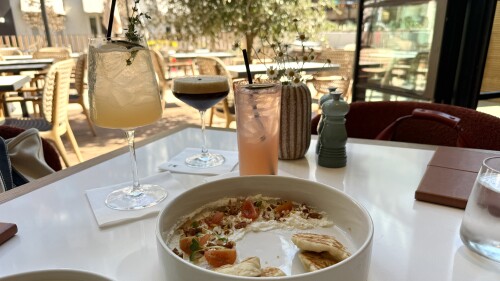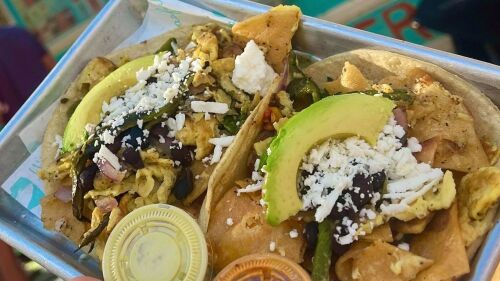The city of Austin was incorporated on Dec. 27, 1839, named in honor of empresario Stephen F. Austin. Now that almost 200 years have passed, the city and its streets are chock-full of vibrant history.
It’s safe to say that over the years, the Capital City has been touched by countless historical figures and happenings — many of which have shaped the names of Austin’s buildings, parks, and streets. In this guide, we’re delving into the history of ATX streets — specifically, how they were named.
Central Austin

“The Drag” on Guadalupe Street looked a little different in 1927.
Photo by Boone via Austin History Center, Austin Public Library
We’re defining this section as the center-most rectangle of the city, stretching from MoPac Expressway to IH-35, between Highway 290 and US-183.
This is where you’ll find most of Austin’s numbered streets, which run east-west and were originally named after trees like Olive, Juniper, Hackberry, and Pecan (like the festival). Meanwhile, Downtown streets running north-south bear the names of Texas rivers.
- Barton Springs Road — This road was named after William “Uncle Billy” Barton, an early settler along the springs, who bought the surrounding land in 1837.
- Koenig Lane — According to the Austin History Center, this drive was likely named after Dr. Joseph Koenig, who founded the Violet Crown Heights neighborhood.
- Lamar Boulevard — This central pathway was named for Mirabeau B. Lamar, one of Austin’s founders who chose the capital city’s location.
- The Swisher Addition — Established in 1877 off of South Congress Avenue, this urban addition has streets named after the family that once owned them: Milton, James, Gibson, Newton, Nickerson, Monroe, Annie, Mary, Elizabeth and Nellie.
- Guadalupe Street — A portion of this street on UT Austin’s campus is nicknamed “The Drag” because streetcars were dragged by mules on it in the late 1800s. “Guadalupe” comes from the Guadalupe River, which was named in the 1680s and honors the Virgin Mary.
East Austin
East Austin is home to Six Square, Austin’s Black cultural district named for six square miles that weren’t fully integrated until the mid-to-late 1970s. This section includes areas east of IH-35.
- Ed Bluestein Boulevard — This street is the namesake of Ed Bluestein, who served 40+ years with the Texas Highway Department, was a member of the Austin Chamber of Commerce, and played tackle in the first UT team to defeat Texas A&M University in football.
- E.M. Franklin Avenue — This street was named Redwood Avenue up until 1995, when it was renamed after a beloved east Austin pastor.
- Manor Road — This street, and neighboring town, were named after James B. Manor, who followed Sam Houston to Austin and settled east of the city.
- Oltorf Street — Mrs. John La Prelle, whose husband developed LaPrelle Place south of the Swisher development, named this street after a relative.
- Waller Street — Edwin Waller, Austin’s first mayor and surveyor of the city, was the inspiration for this street’s name.
- Windsor Park — This strip was named after Windsor, Connecticut by Gov. Elisha Pease.
West Austin

Here’s what the MoPac overpass at Windsor Road once looked like, though the creation date of this photograph is unknown.
Photo by Ronald Vaughn via Austin History Center, Austin Public Library
One of the oldest districts and neighborhoods in the city, west Austin was established in 1853. The area was the site of many plantations owned by Gov. Pease, who later sold the land and homes to formerly enslaved individuals.
The northern edge of west Austin would later be named Clarksville after a formerly enslaved man named Charles Clark helped establish the neighborhood, one of the first freedom colonies west of the Mississippi River.
- Enfield Road — Enfield Road and some surrounding streets, including Cromwell Hill and Poquonock, were named for Gov. Pease’s hometown in Enfield, Connecticut.
- Exposition Boulevard — This path on the way to Camp Mabry was the site of many fairs and “expositions.”
- Pease Suite — Like the Swisher Addition, Niles Graham, grandson of Gov. Pease, also used family names when naming the streets near his west Austin home: Marshall, Murray, Niles, and Pease.
South Austin
This area of town hasn’t always been the city’s priority in terms of development, which leads some to think it has held onto some “old Austin” charm. We’re including streets south of Highway 290 in this section.
- Ben White Boulevard — This section of 1st Street was renamed after 16-year Austin City Council veteran “Uncle Ben” White in 1958.
- Slaughter Lane — This street was named after the nearby Slaughter Creek, which itself was named after Stephen F. Slaughter, one of the first Travis County settlers.
- William Cannon Drive — This drive is named for soldier William Cannon of the Battle of San Jacinto, who owned land and a trading post on Onion Creek in the early 1800s.
- Menchaca Road — Despite a longstanding debate over the origin and pronunciation of this road, many locals believe it to be named after Jose Antonio Menchaca, a Texas army captain who helped win the Battle of San Jacinto.
North Austin
What Austinites define as “North Austin” keeps moving further north. When Waterloo (Austin’s first name) was established in 1839, the northern-most border was 15th Street. Now, we’re only including streets further north than US-183.
- Anderson Mill Road — Named after Thomas Anderson’s mill, which made gunpowder for the Confederacy in the 1860s.
- Jollyville Road — This road was named after Civil War veteran and blacksmith John Grey Jolly, who lived in the area in the late 1800s.
- McNeil Drive — This road, plus a high school and unincorporated town, was named after Austin and Northwestern Railroad regional manager George McNeil.
- Parmer Lane — The source of this lane’s name remains a mystery, but many locals think it was coined for former Austin Mayor Lester Palmer.
This barely scratches the surface of how many historical streets can be found in Austin. What do you think is the most interesting historical street? Let us know.












